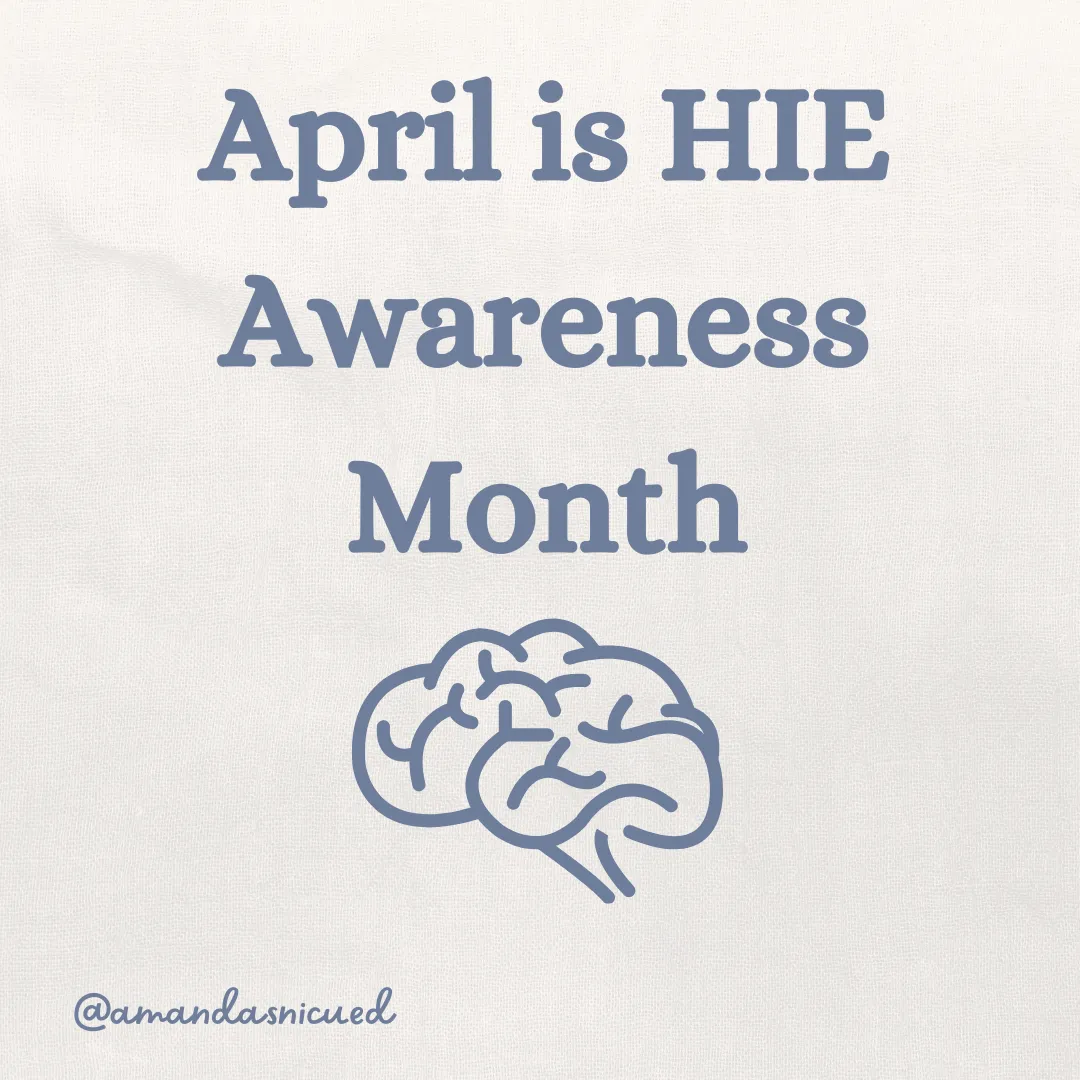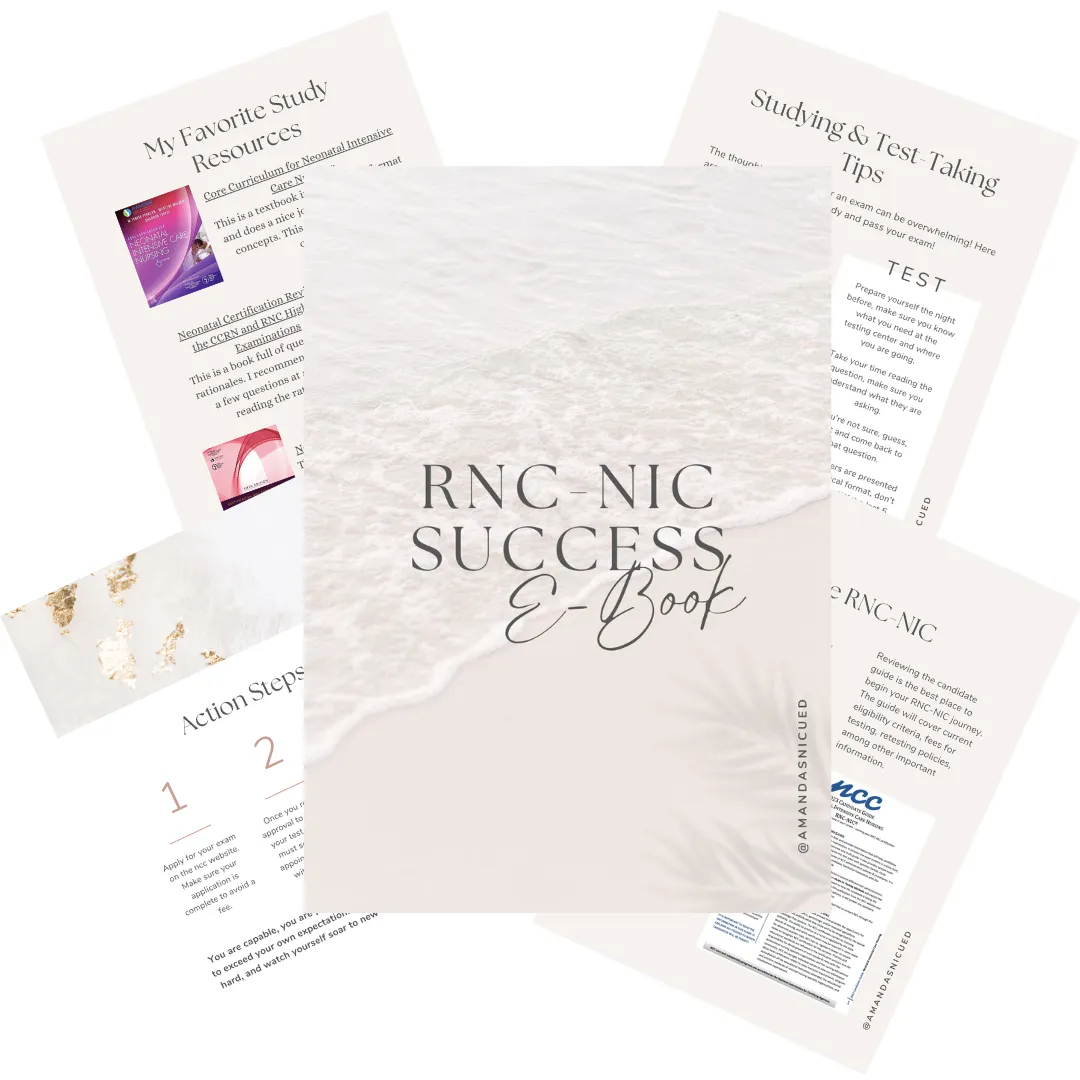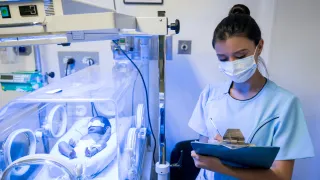
Welcome to Amanda's NICU Education




Hi! My name is Amanda. I'm a NICU nurse, Clinical Nurse Specialist, NICU Educator... basically your NICU BFF. If you want to talk NICU, I'm here for you! I love everything about NICU nursing and I'm eager to learn and share my knowledge with all my NICU friends.
I have been a NICU nurse since 2009 I am currently a Clinical Nurse Specialist in a Level IV NICU in Los Angeles.
I am passionate about educating the next generation of NICU nurses. I share my knowledge through platforms such as Instagram and Facebook and am excited to have you here on my website!
Click on the button below to sign up for my newsletter filled with NICU education and tips for all experience levels.

Not very many people love taking tests but as a self-acclaimed "forever student" who has taken (and passed) five different certification exams I am no longer afraid of tests! "Way to brag", you might be thinking but I want to help YOU pass your certification exam too!
Introducing Amanda's RNC-NIC Success digital course - your ultimate study companion!
Gain unlimited, on-demand access for life, ensuring you're primed to ace your certification exam.
I'm here to help you succeed and I can't wait for you to share with me that you PASSED the RNC-NIC EXAM!!!










April is HIE Awareness Month
April is HIE Awareness Month,
April is always a jam packed busy month for me. In my NICU, we have skills lab every year during April and that always keeps me on my toes. No matter how busy I am, I always take a moment to reflect on all the sweet babies with HIE I have taken care of over the years and the impact HIE has on them and their family.
If you don't already I highly encourage that you follow Hope for HIE on instagram. They are a wonderful nonprofit that raises awareness about HIE, advances research, and offers support to families affected by HIE.
Another amazing resource to learn about all things Neuro NICU is from Synapse Care Solutions! They have an amazing YouTube channel and offer so much education and courses. I love seeing all the webinars and have purchased nearly all of their courses. Go check them out on YouTube!
Let's Review HIE
Hypoxic Ischemic Encephalopathy (HIE) is caused by a significant event in the peripartum period that pauses blood flow and oxygenation to the body. This event triggers a cascade of biochemical events that lead to brain cell injury and death. Understanding the sequence of events helps us as NICU nurses provide the best possible care to our patients.

HIE: Phases of Injury
At the cellular level, there are many changes that occur after a hypoxic ischemic injury. These occur is a series of phases: primary, latent, secondary, and tertiary phases. Let's review each of them together:
Primary Injury:
During the primary injury phase, there is a decrease of blood flow and therefore decreased cerebral oxygenation and glucose delivery. As we know when there is poor delivery of oxygen and glucose to the tissues the body will go into anaerobic metabolism, depleting ATP and producing lactic acid. Without ATP as an energy source, certain cellular mechanisms can no longer function normally (Na/K ATPase pump).
When the Na/K ATPase pump is unable to function normally, the neuronal cell membranes become depolarized which allows sodium and calcium to flood into the cell causing cytotoxic edema. High intracellular levels of calcium stimulate the activation of nitric oxide which damages the mitochondrial membrane and leads to mitochondrial dysfunction. All this leads to an inflammatory response and apoptosis (programmed cell death).
I love this video from Osmosis that shows what is happening at the cellular level when there is hypoxia. I show it to my students every year in our Therapeutic Hypothermia class. Click on the button below to watch.
Let's visualize what happens when cells are hypoxic
Latent Phase:
The latent phase is characterized by cerebral reperfusion and improved oxygenation which improves the cytotoxic edema. During this phase the neurotoxic cascade is briefly suppressed and the patient may appear clinical improved. This is the ideal time to initiate therapeutic hypothermia.
Secondary Phase of Injury:
The secondary phase of injury is believed to occur around 6 hours after the injury. The energy stores that were repleted during the latent phase are now gone and cytotoxic edema, mitochondrial failure, and accumulation of excitotoxins, cytokines, and ultimately cell death occurs.
Tertiary Phase of Injury:
This phase can last weeks to months and is characterized by a reparative and restorative process. Dead cells are cleaned up by phagocytosis which also releases an influx of anti-inflammatory cytokines.

Douglas-Escobar, M., & Weiss, M. D. (2015). Hypoxic-ischemic encephalopathy: a review for the clinician. JAMA pediatrics, 169(4), 397–403. https://doi-org.mlprox.csmc.edu/10.1001/jamapediatrics.2014.3269
Treatment
When caring for a patient with HIE the gold standard treatment is therapeutic hypothermia (TH). TH should be initiated as soon as possible, within the first 6 hours of life. TH slows metabolism and allows the cells to recover from the neurologic damage. Babies who have experienced HIE don't only have a neurologic injury, the hypoxic ischemic injury causes multisystem dysfunction and each system requires care.
Initially, infants with HIE have metabolic acidosis and may have a low CO2 level to compensate. Support respiration and be careful to maintain CO2 within a normal range. Hypocapnea causes vasoconstriction decreases cerebral perfusion which can result in poor outcomes. Hypercapnea will cause vasodilation and cerebral acidosis triggering more blood flow to the uninjured areas of the brain (known as a "steal phenomenon"). CO2 should be maintained at 40-55mmHg
Many infant with HIE may have cardiac dysfunction, warranting inotropes (such as epinephrine) to augment their blood pressure. Some infants with HIE may also have pulmonary hypertension, in these cases milrinone can help improve contractility and act as a systemic and pulmonary vasodilator.
Fluid restriction, with a target of 40-60mL/kg/day, is provided to infants with HIE to prevent fluid overload. These babies can experience renal dysfunction (e.g. acute tubular necrosis & SIADH) which predisposes them to volume overload.
Feedings are typically withheld, or given as trophic feedings, until after rewarming and bowel sounds are audible.
Hepatic dysfunction results in a risk of coagulopathy. PT, PTT, fibrinogen, and platelets must be monitored and abnormalities can be corrected with fresh frozen plasma, cryoprecipitate, or platelet transfusion.
HIE is the most common cause of seizures in the newborn, therefore EEG/aEEG and seizure control is another important aspect of NICU care. Seizures can exacerbate neurologic injury, and metabolic disturbances (hypoglycemia, hypocalcemia, hyponatremia) can exacerbate seizures. The first line anticonvulsant is phenobarbital, which is given as a loading dose of 20mg/kg. If seizures continue another loading dose of 5-10mg/kg may be given to control the seizures. Due to hepatic and renal dysfunction that accompanies HIE, these babies must be closely monitored for signs of respiratory depression and levels must be drawn to ensure the phenobarbital is in therapeutic range (15-40mcg/mL). If seizures are not well controlled with phenobarbital, another anticonvulsant may be added (Phenytoin, fosphenytoin, or Levetiracetam).
After therapeutic hypothermia has been completed, a MRI is obtained to assess the injury and follow up care is provided from a Neurologist and High Risk Infant Progress Clinic.
During treatment the NICU RN is crucial in providing support to the family during this scary and traumatizing time. Providing education and resources helps family members better understand their babies condition, the care that is being provided, and the road ahead. We can offer emotional support and validate their feelings of fear and grief. We can also celebrate the milestones, which offers encouragement and hope. I always like to let my families know about Hope for HIE a wonderful place for support.

I hope this was an informative review for you! Want to learn more about neonatal care and become a certified NICU nurse? Now is the perfect time! Enroll now in my Study Group for the RNC-NIC. We will be meeting on zoom once a month to discuss all things NICU nursing. I hope to see you there!
Warm regards,
Amanda xoxo
Missed my other newsletters? Click here to read them!
Let's Study Together! Join my Certification Course
References:
Mietsch, U., & Juul, S. (2024). Neonatal Encephalopathy in Avery's Diseases of the Newborn (11th Ed.) Elsevier
Osmosis. (2017). Hypoxia & Cellular Injury. Retrieved from https://www.youtube.com/watch?v=JcGKDDvk5AQ
Douglas-Escobar, M., & Weiss, M. D. (2015). Hypoxic-ischemic encephalopathy: a review for the clinician. JAMA pediatrics, 169(4), 397–403. https://doi-org.mlprox.csmc.edu/10.1001/jamapediatrics.2014.3269
Hansen, A. R. (2016). Cloherty and Stark's Manual of Neonatal Care (8th ed.). Wolters Kluwer Health. https://online.vitalsource.com/books/9781496365347

December 2023 Certification Review Webinar
NICU Certification Review



Ready to kickstart your journey to becoming a certified NICU nurse?
Look no further!
Grab my FREE E-Book packed with essential study and test-taking strategies for the RNC-NIC.
In the E-Book I give you the resources you need including the link to access the candidate guide, several types of books to study from, some of my favorite strategies, an outline of the content you should review, and a blank calendar for you to make your study plan!
Frequently Asked Questions About the RNC-NIC exam

What is the RNC-NIC?
The RNC-NIC is a competency-based exam that tests the specialty knowledge of nurses in the United States & Canada who care for critically ill newborns and their families.
The RNC-NICU is a nationally recognized certification that recognizes the registered nurse for their specialty knowledge and skill.

Who can take the RNC-NIC exam?
Nurses can take this exam after a minimum of two years experience in the NICU caring for critically ill newborns and their families.

Which books should I use?
I'm glad you asked! There are many excellent books to help you prepare for the RNC-NIC, I gathered ande describe each of them for you in my FREE e-book.
Is there a course to help me study?
Yes! Many hospitals host their own certification course and there are a few online courses. See my RNC-NIC test taking tips E Book for more information
What happens if I don't pass the exam?
If you don't pass the exam on your first try you can try again after 90 days. You will have to reapply after 90 days and pay a retest fee. There is no limit to the number of times you can take the exam (however a candidate can only sit for the exam twice per year).

Can I make more money if I take the RNC-NIC exam and get certified?
Yes! Many hospitals provide a raise or a bonus for nurses with specialty certifications. Hospitals also typically hire at a higher base salary when nurses have a certification.

Find me @amandasnicued on these channels or Email me
hey nurses don't miss out
© Copyright 2024. AmandasNICUEd. All rights reserved. | Terms & Conditions | Privacy Policy Contact: [email protected]

